2012 Week 9
On Saturday and Sunday we held our annual public event called Tidewater Archaeology Weekend.
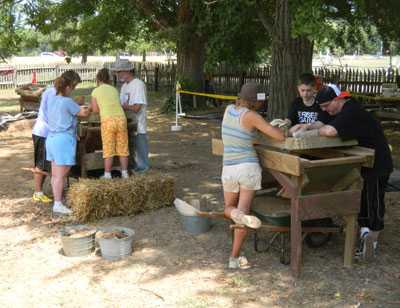
Students and the public screening on Tidewater Archaeology Weekend.
We invite the public to the site and let them help screen for artifacts. It gives the students a chance to show off what they have learned over the past 8 weeks. They are the ones who identify the artifacts and get to say, over and over again, “no, that’s just a rock,” which Mark and I have said so many times to them. We had a good crowd and all, adults and children, seemed to have a good time.
The units we excavated for this weekend were in the area of the north wall of Pope’s Fort, the 1645 fortification set up around the house when the Protestants rebelled against Lord Baltimore as part of the English Civil War. The artifacts recovered from this area include the full range of items from the site, lots of ceramics, tobacco pipes and other items. One of the more interesting was a small piece of an embossed pipe bowl, probably Dutch, showing some type of animal.
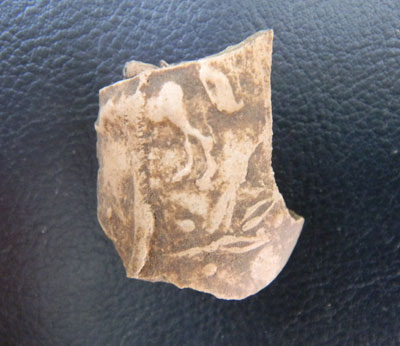
Embossed pipe bowl fragment.
A lot of these pipes date to the latter part of the 17th century but this piece will need more research.
Before the weekend, work continued in the Calvert House area.
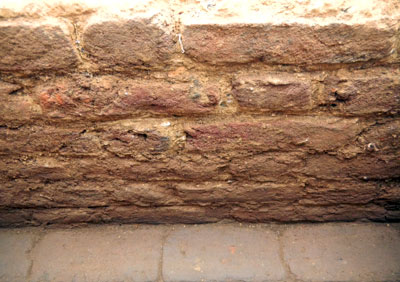
Brick cellar wall illustrating Flemish Bond pattern.
Last week I reported that the interior wall of the brick cellar was laid in Flemish Bond, that is with bricks laid in an alternating pattern of headers, the short end of the brick, and stretchers, the long edge of the brick, in the same row. We have now learned that the wall was built very cheaply with the back row of stretchers, which would not be seen, replaced by broken bricks. As this wall was not structural, it did not have to be strong. It just needed to look good. The cellar is 16 ft. long, north to south, and 8 ft. wide, east to west. In the 1980s, a bulkhead entrance was found on the southwest corner.
As we cleaned the last of the fill from the cellar, the brick floor became visible.
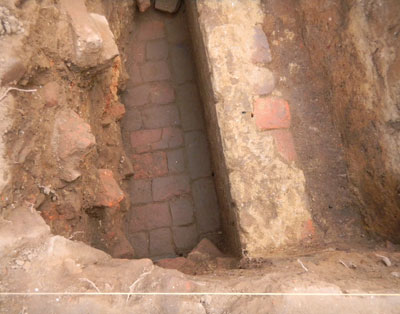
Brick floor of the cellar.
Like the back of the cellar wall, most of the floor was made up of brick bats, mostly half bricks. The exception seems to have been the row of whole bricks laid neatly against the cellar wall. At the moment, we have such a small window on the floor layout that we cannot be more specific. The floor is currently 4.65 ft. below the present surface and the cellar would have been about 5 ft. high below the house.
There were not many artifacts in the fill of the cellar so we were surprised to find a complete door lock lying directly on the brick floor.
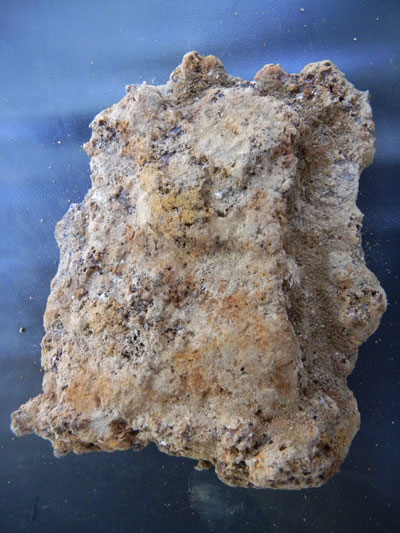
Large iron lock found on the cellar floor.
Future conservation will give us a better idea of the nature of this piece. Was this from the door of the cellar? Did it come from the house above? These are the kinds of questions that cannot be answered by archaeology but make it interesting to speculate.
Having found the interior wall of the cellar, we opened a unit along the south wall of the house foundation to see the relationship of the cellar wall, one and a half bricks wide and deep, with the house foundation, sandstone with brick on top and relatively shallow.
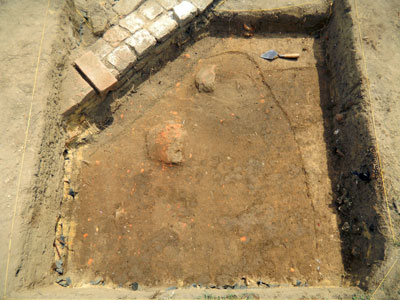
Builders trench for the brick cellar on south side of the house.
This was one of our major research goals for the summer. Was the brick cellar part of the construction of the house or a later addition? The photo shows the builder’s trench for the cellar. It cuts through a fence line, seen in the upper right and is cut by the builder’s trench of the 1840s smokehouse, in the upper left.
Several lines of evidence point to the cellar being a later addition to the house. The fence line in the photo already existed and ran up to the house before the cellar was built. The cellar builder’s trench cuts though earlier features associated with the house foundation. When the cellar was built is still uncertain but the wall referred to above, built in Flemish Bond, suggests that it was in the 1670s. However, until we can see more of the wall, this will remain uncertain. It is possible that the Flemish Bond wall was a later repair of an existing cellar. We have no evidence of it but we cannot rule it out.
Work also continued in the burned clay cellar this week. At the top of the cellar was a thin layer of ash and charcoal which dated to the early part of the 17th century, perhaps the late 1640s or 1650s. Some of the strongest evidence of this date comes from the assemblage of early pipes found in this stratum.
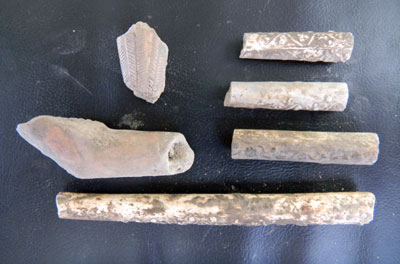
Selection of early 17th-centry pipes from the top layer
of the burned clay cellar.
It includes a large number of elaborately molded pipe stems along with terra cotta pipe fragments. These types of tobacco pipes are much more common before 1660. In addition, the ceramics found here were all early with no later types being recovered.
One of the most exciting artifacts of the summer was recovered from the ash layer on the top of the burned clay cellar.

Part of a bone cross from the top layer of the early cellar.
This is a small piece of elaborately carved bone, probably done on a lathe, with a single hole through the middle. It is about an inch and a half long. By itself, this is a cool artifact even if we did not know what it might have been. Research on the web turned up a picture of a similar piece on a rosary from the 18th century preserved in Germany.
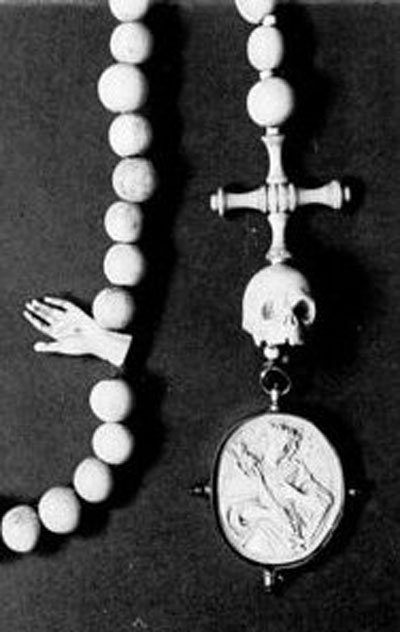
Similar cross on an early 18th-century rosary from Germany.: http://paternosters.blogspot.com/2005_03_01_archive.html
The cross on the rosary has many similarities to our piece from the cellar.
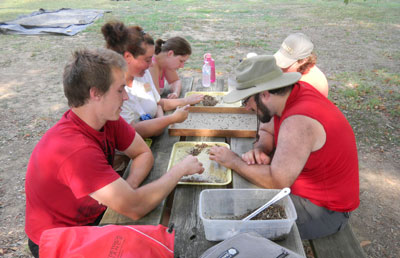
Students picking through water-screened material.
Because the ashy layer had a lot of charcoal and small bone fragments in it, we decided to water screen a sample. When a layer seems to be rich in very small items, we will take a sample and fine screen it through window screen using a hose to force the dirt through. The dirt is first put through our normal screen to remove the bigger things and then a one cubic foot sample is collected. This is washed in the window screen and the residue is carefully sorted to recover any cultural items. Students who do this get to sit in the shade all day – a very popular activity on hot days.
The water screened sample of the ash layer had significant amounts of small bone, fish scales, small lead shot, and small fragments of ceramic. It also included a number of beads.
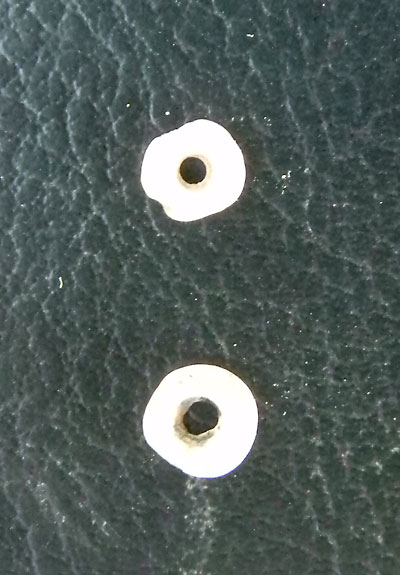
Two small shell beads from the water-screened material.
There were perhaps half a dozen shell beads like the two in the photo and three glass seed beads.
The ash layer had a wonderful collection of artifacts and was a very soft and easy stratum to excavate. However, directly below it we encountered what appears to be a clay cap of the cellar. The stratum consists of a bright yellow clay with hardly any artifacts and hard as concrete. To get through it we had to use a pickaxe. After a foot and a half of work, we found a darker layer peeking out of the bottom. This coming week, we will remove the last of the clay cap and everyone is excited to see what else the cellar tells us.


